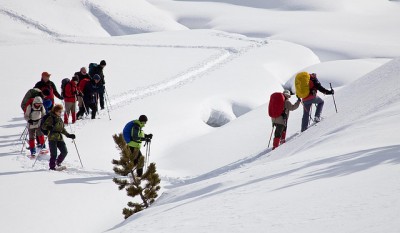
Snowshoeing is an activity some people may overlook in snowy months. When you hear “winter sports”, skiing, snowboarding and ice-skating are probably your first thoughts. The cool thing about snowshoeing is that it’s just as easily accessible a sport as the rest of ’em. Some nature sites designate trails for snowshoe-ers, but really you are free to hike wherever there is legal land to do so. Equipment is cheap and rentals are available. Because this is a low-impact activity, it’s all inclusive. Children, adults and elders can all participate.
Snowshoeing has been around for 4,000 years now and we’ve made great technological advances in snowshoeing equipment since then, but you can still have the experience of making your own snowshoes. The Michigan DNR offers snowshoe-making courses each season. Some places even offer ranger-led snowshoe walks to get acclimated to the activity and the wildlife under the wing of a professional.
To rent equipment, call or go into your local sports equipment store to ask if they rent out equipment. REI does rentals and even an informational session. Check their website for prices and availability. Many guide businesses, lodges or small businesses at your location of choice will rent snowshoes as well. I recommend trying out a rental before you make a purchase so that you decide what style and make suits you best.
What to look for:
 Size is not the deciding factor in your snowshoe-purchasing endeavor, the terrain in which you will most often use your snowshoes is. How wet, dense or dry is the snow usually? Your snowshoes’ main goal is to provide traction and stability.
Size is not the deciding factor in your snowshoe-purchasing endeavor, the terrain in which you will most often use your snowshoes is. How wet, dense or dry is the snow usually? Your snowshoes’ main goal is to provide traction and stability.- Oftentimes you will need extra traction to ascend a steep hill and to keep from sliding on your way back down the hill. If you will be using your snowshoes to climb hills or mountains, make sure to get a snowshoe with plenty of traction. You want many of those toothy, little spikes (crampons) on the bottom of the shoe.
- Also, if you’re going to be frequently climbing in a hilly or mountainous region, some snowshoes have a heel-elevator. This is not standard, so be sure to ask when renting or purchasing snowshoes. A heel elevator is usually just a little bar that clips up to give your heel extra height. This really takes the stress off your lower leg when walking uphill.
- Bindings can be complicated or simple. A binding simply keeps your boot attached to the snowshoe. Bindings are commonly rubber straps, but can also be plastic cuffs and even similar to the bindings found in snowboards. Are the bindings easy to attach with gloves on? Wear the gloves you will use when trying on snowshoes.
- How much do you weigh? Or, how much will you weigh combined with a backpack? This will determine the size of your deck, or the surface-area of the shoe. The deck can be solid and plastic, or webbed rawhide like in older and homemade shoes. While pretty much any size shoe can fit any snowshoe, the deck-size should be specific to the person. The more you weigh (counting backpack weight as well), the bigger the deck should be.
- Clip-on tails are available. A tail just adds extra length to your snowshoe which is useful when you’re in deep snow, if you weigh a lot, or if you only need it when you so seldom hike with a backpack.
Snowshoeing allows you to check out those pristine areas of snow-covered terrain that would otherwise be inaccessible in a regular snow boot. If you do decide to purchase your own snowshoe, expect to pay anywhere between $100 to $250 for a new pair. Revel in the joy of hiking your favorite trails without bugs harassing you the whole way!
Now, just go try some styles on. I advise you to rent out the snowshoe you intend to buy first. That way you’ll come to find if it’s perfect for you or not. Does your foot slip and slide around in the snowshoe? Does the shoe flick snow down the back of your neck? Does the binding hurt your foot? Is a soft attachment (fixed-toe cord) or hard attachment (rotating-toe cord) ideal for you? Ask at your local supplier, just be sure to wear the shoes you will snowshoe in when trying out a pair. Regular winter boots are ideal, do not wear your snowboarding or ski boots when snowshoeing.
Photo: (snowshoe-ers) alh1, (snowshoes) Rebecca

 Your Privacy Choices
Your Privacy Choices
 The
The